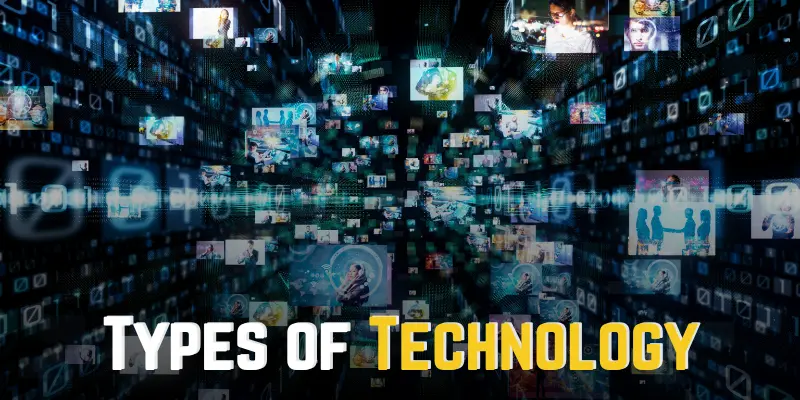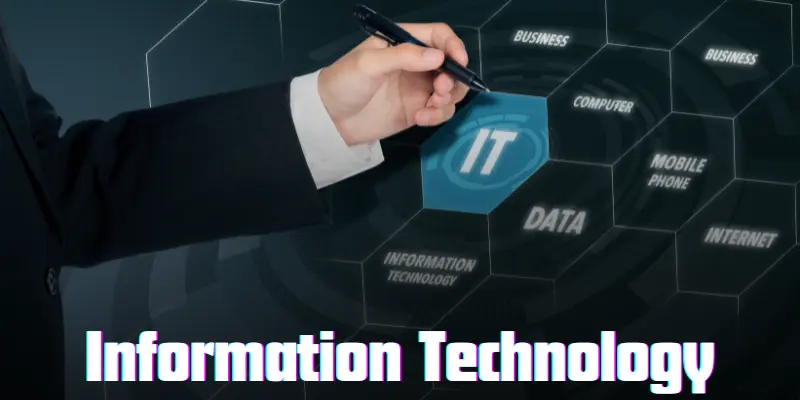Types of Technology: Shaping the Future of Innovation
Published: 23 Jan 2025
My dear, I want you to know about that, technology is all around us, shaping the way we live, work, and connect with the world. From the smartphones in our pockets to the advanced systems powering industries, technology comes in many forms, each serving unique purposes.
Understanding the different types of technology—whether it’s communication, medical, or transportation technology—helps us make better choices, stay informed about innovations, and appreciate how these advancements improve our daily lives. Whether you’re a tech enthusiast or just curious, exploring the various Types of Technology can open your eyes to the incredible ways it shapes our future.
Technology plays a vital role in shaping our modern world, influencing nearly every aspect of our daily lives. From communication and healthcare to transportation and entertainment, different types of technology help us work smarter, stay connected, and improve our quality of life. Understanding these various types allows us to appreciate their impact and make informed decisions about how we use them.
Types of Technology:
- Financial Technology (FinTech)
- Artificial Intelligence (AI) Technology
- Robotics Technology
- Information Technology (IT)
- Technology in Healthcare
- Technology in Business
- Space Technology
- Educational Technology
- Construction Technology
- Agricultural Technology
- etc
Okay My Friend! Here are some Types of Technology. Now let me explain to you the important ones in detail.

1. Financial Technology (FinTech)
Definition
Financial Technology, or FinTech, refers to the use of digital technology to improve, automate, and innovate financial services. It encompasses a wide range of applications, including mobile banking, online payments, blockchain, and investment management platforms. FinTech aims to make financial transactions faster, more secure, and accessible to a larger audience by leveraging cutting-edge technology.
Key Features
- Digital Payments: Online and mobile payment solutions allow users to transfer money easily and securely.
- Blockchain and Cryptocurrencies: Decentralized digital currencies and smart contracts provide secure, transparent financial transactions.
- Artificial Intelligence (AI) in Finance: AI-driven analytics assist in fraud detection, credit scoring, and personalized financial advice.
- Robo-Advisors: Automated investment platforms that provide financial planning with minimal human intervention.
- RegTech (Regulatory Technology): Tools that help financial institutions comply with legal regulations efficiently.
- Peer-to-Peer (P2P) Lending: Platforms that connect borrowers directly with lenders, bypassing traditional banks.
Applications
- Mobile Banking: Apps that allow customers to manage accounts, transfer money, and pay bills from their smartphones.
- Digital Wallets: Services like PayPal, Apple Pay, and Google Pay enable cashless transactions.
- Cryptocurrency Exchanges: Platforms for buying, selling, and storing digital currencies such as Bitcoin and Ethereum.
- Investment and Trading: Online platforms that provide real-time stock market analysis and automated trading.
- InsurTech (Insurance Technology): Digital solutions for purchasing and managing insurance policies with greater transparency.
- Crowdfunding Platforms: Online platforms that allow individuals and businesses to raise funds from a large audience.
- Buy Now, Pay Later (BNPL): Payment models that let consumers make purchases and pay in installments.
Benefits
- Convenience: FinTech services provide 24/7 access to financial resources from anywhere in the world.
- Cost Efficiency: Automation reduces operational costs for financial institutions and lowers fees for customers.
- Increased Financial Inclusion: FinTech solutions make financial services accessible to underserved populations.
- Enhanced Security: Advanced encryption and biometric authentication enhance transaction security.
- Faster Transactions: Instant payments and automated processes reduce waiting times compared to traditional methods.
- Personalized Services: AI-driven analytics offer customized financial advice and investment suggestions.
Challenges
- Cybersecurity Risks: FinTech platforms are prime targets for hackers, requiring robust security measures.
- Regulatory Compliance: Adapting to different financial regulations across countries can be complex and costly.
- Digital Divide: Not everyone has access to the internet or smartphones, limiting FinTech adoption.
- Fraud and Scams: As digital transactions increase, so do fraudulent activities and identity theft.
- Technical Issues: Dependence on technology means that system failures or downtimes can disrupt financial operations.
- Privacy Concerns: Collection and storage of sensitive financial data raise ethical and legal questions.
Future Trends
- Blockchain Expansion: Greater use of decentralized finance (DeFi) and blockchain solutions in mainstream financial services.
- AI-Powered Financial Services: Increased adoption of AI for fraud detection, risk assessment, and customer support.
- Open Banking: Financial institutions sharing data securely with third-party providers for better financial solutions.
- Biometric Authentication: Enhanced security measures using fingerprint, facial recognition, and voice authentication.
- Green FinTech: Sustainable financial solutions focused on eco-friendly investments and reducing carbon footprints.
- Embedded Finance: Financial services integrated into non-financial platforms, such as e-commerce and social media.
2. Artificial Intelligence (AI) Technology
Definition
Artificial Intelligence (AI) Technology refers to the development of computer systems that can perform tasks typically requiring human intelligence. These tasks include problem-solving, learning, reasoning, perception, and language understanding. AI systems analyze vast amounts of data, recognize patterns, and make decisions with minimal human intervention. AI is widely used across industries to automate processes, enhance efficiency, and provide intelligent solutions.
Key Features
- Machine Learning (ML): AI systems can learn from data, improving their performance over time without explicit programming.
- Natural Language Processing (NLP): Enables machines to understand, interpret, and generate human language (e.g., chatbots, voice assistants).
- Computer Vision: AI can analyze and interpret visual data, such as images and videos, for tasks like facial recognition.
- Automation: AI automates repetitive tasks, reducing the need for human involvement in routine processes.
- Predictive Analytics: AI algorithms analyze data to predict future trends and behaviors.
- Personalization: AI tailors recommendations based on user preferences, such as in streaming services and e-commerce.
Applications
- Healthcare: AI assists in medical diagnosis, personalized treatment plans, and robotic surgeries.
- Finance: AI-driven algorithms help detect fraud, automate trading, and provide financial advice.
- Retail: Personalized shopping experiences, inventory management, and demand forecasting.
- Transportation: Self-driving cars, traffic management, and logistics optimization.
- Customer Service: AI chatbots and virtual assistants handle customer queries efficiently.
- Education: Adaptive learning platforms provide personalized education based on student progress.
- Manufacturing: Predictive maintenance, quality control, and automated production processes.
Benefits
- Efficiency Improvement: AI can process large amounts of data quickly and accurately, improving productivity.
- Cost Reduction: Automation of tasks reduces operational costs and enhances profitability.
- 24/7 Availability: AI systems can work continuously without breaks, offering round-the-clock service.
- Enhanced Decision-Making: AI provides data-driven insights that help in making informed decisions.
- Personalized Experiences: AI tailors products and services to meet individual needs.
- Error Reduction: AI minimizes human errors in complex and repetitive tasks.
Challenges
- Data Privacy Concerns: AI systems require large amounts of data, raising concerns about privacy and security.
- Bias in Algorithms: AI models can inherit biases present in training data, leading to unfair outcomes.
- High Implementation Costs: Developing and deploying AI solutions can be expensive.
- Job Displacement: Automation may lead to job losses in some industries.
- Lack of Explainability: Some AI models function as “black boxes,” making it difficult to understand their decision-making processes.
- Ethical Concerns: AI can be misused for surveillance, misinformation, and other unethical purposes.
Future Trends
- AI-Powered Healthcare: Greater advancements in AI-assisted diagnosis and personalized medicine.
- Autonomous Vehicles: Continued development of self-driving technology for safer and more efficient transportation.
- AI and IoT Integration: Smart homes and cities that rely on AI-driven IoT devices for automation.
- Explainable AI: Development of AI models that provide transparent and understandable decision-making.
- AI Ethics and Regulations: Stricter policies and guidelines to ensure responsible AI usage.
- General AI Development: Progress towards AI systems that possess human-like cognitive abilities across multiple domains.
3. Robotics Technology
Definition
Robotics Technology refers to the design, development, and application of robots—machines that can perform tasks autonomously or with human guidance. These robots can range from simple automated devices to advanced AI-driven systems capable of learning and adapting to their environment. Robotics technology is widely used in industries such as manufacturing, healthcare, agriculture, and even space exploration.
Key Features
- Automation: Robots are designed to perform repetitive tasks with high precision and minimal human intervention.
- Artificial Intelligence (AI): Many modern robots are equipped with AI to analyze data, make decisions, and learn from experience.
- Sensors and Actuators: Robots use sensors to perceive their surroundings and actuators to perform physical movements.
- Human-Robot Interaction (HRI): Advanced robotics systems can understand and respond to human commands through voice or gesture recognition.
- Mobility: Robots can have wheels, legs, or flying capabilities to navigate different environments.
- Programmability: Robots can be programmed to perform a variety of tasks based on the needs of users.
Applications
- Manufacturing: Industrial robots assist in assembly lines, welding, and packaging, improving production efficiency.
- Healthcare: Robots assist in surgeries, rehabilitation, and patient care, enhancing medical precision and support.
- Agriculture: Automated machines help with planting, harvesting, and monitoring crops for better productivity.
- Defense and Security: Robots are used for surveillance, bomb disposal, and reconnaissance in dangerous environments.
- Space Exploration: Robotic rovers and probes explore planets and distant locations where humans cannot go.
- Household Assistance: Domestic robots like vacuum cleaners, lawn mowers, and personal assistants help with daily chores.
Benefits
- Increased Efficiency: Robots can work faster and more accurately than humans, leading to higher productivity.
- Cost Savings: Automation reduces labor costs and minimizes human errors.
- Improved Safety: Robots can handle hazardous tasks in environments that are dangerous for humans, such as toxic waste management.
- Consistency and Precision: Unlike humans, robots do not experience fatigue, ensuring consistent quality.
- 24/7 Operation: Robots can work continuously without breaks, leading to improved output in industries.
- Accessibility: Robots assist people with disabilities, providing independence and support in daily activities.
Challenges
- High Initial Investment: The cost of developing and implementing robotic systems can be substantial.
- Job Displacement: Automation may lead to reduced demand for human labor in certain sectors.
- Technical Complexity: Designing, programming, and maintaining robots require specialized skills and expertise.
- Ethical Concerns: There are concerns about privacy, data security, and the ethical implications of AI-driven robots.
- Maintenance Requirements: Robots need regular maintenance and upgrades to function effectively.
- Limited Adaptability: Some robots may struggle with complex, unpredictable tasks that require human-like decision-making.
Future Trends
- Humanoid Robots: Development of robots that can mimic human actions and emotions for social interaction and assistance.
- Collaborative Robots (Cobots): Designed to work alongside humans safely in workplaces, enhancing productivity.
- Autonomous Vehicles: Self-driving cars and drones using robotics and AI to navigate without human intervention.
- AI-Powered Robotics: Machines that can learn and adapt in real time, improving their functionality and decision-making.
- Medical Robotics: Enhanced robotic assistance in surgeries, elderly care, and personalized healthcare solutions.
- Swarm Robotics: Coordinated robotic systems that work together to complete complex tasks efficiently.
4. Information Technology (IT)

Definition
Information Technology (IT) refers to the use of computers, networks, software, and other digital tools to store, process, and share information. IT encompasses a wide range of technologies that help individuals and organizations manage data efficiently and securely. It plays a crucial role in various sectors, including business, education, healthcare, and entertainment.
Key Features
- Data Management: IT enables the storage, retrieval, and processing of large amounts of data.
- Connectivity: Facilitates communication and data exchange through networks like the internet and intranets.
- Automation: Helps automate tasks and processes, improving efficiency and reducing human effort.
- Security: Provides measures to protect sensitive information from cyber threats and unauthorized access.
- Cloud Computing: Offers remote access to data and services through the internet.
- Scalability: IT systems can be expanded or reduced based on business or personal needs.
Applications
- Business Operations: IT systems streamline operations, manage customer relationships, and facilitate e-commerce.
- Healthcare: Electronic health records, telemedicine, and data analytics improve patient care and hospital management.
- Education: Online learning platforms, digital libraries, and virtual classrooms enhance educational experiences.
- Entertainment: Streaming services, video games, and digital content creation rely heavily on IT.
- Communication: Email, instant messaging, and video conferencing tools support personal and professional interactions.
- Banking and Finance: IT enables online banking, secure transactions, and financial data analysis.
Benefits
- Efficiency Improvement: Automates routine tasks, saving time and reducing manual efforts.
- Global Connectivity: Allows instant communication and collaboration across different locations.
- Data Accuracy: Reduces errors by automating data entry and analysis processes.
- Cost-Effectiveness: IT solutions help businesses save costs by optimizing resources and reducing paperwork.
- Security Enhancement: Provides encryption, firewalls, and other security measures to safeguard information.
- Remote Access: Enables people to work or access information from anywhere, increasing flexibility.
Challenges
- Cybersecurity Threats: Data breaches, hacking, and malware pose significant risks to IT systems.
- Constant Upgrades: Rapid technological advancements require regular updates and training.
- Privacy Concerns: Protecting personal data from misuse remains a major challenge.
- Dependence on Technology: Over-reliance on IT can lead to disruptions in case of system failures.
- Cost of Implementation: Setting up advanced IT infrastructure can be expensive for small businesses.
Future Trends
- Artificial Intelligence (AI) Integration: AI-powered systems will enhance automation and decision-making.
- Blockchain Technology: Offers secure and transparent transactions for industries like finance and healthcare.
- 5G Connectivity: Faster and more reliable internet will revolutionize IT applications.
- Edge Computing: Processing data closer to its source for improved speed and efficiency.
- Cybersecurity Advancements: Stronger security measures, including biometric authentication and advanced encryption.
- Cloud Expansion: More businesses will adopt cloud-based solutions for flexibility and scalability.
5. Technology in Healthcare
- Medical Devices and Equipment: Tools like MRI, CT scanners, and robotic surgery systems help diagnose and treat patients with high precision.
- Telemedicine: Enables remote consultations between doctors and patients, improving access to healthcare, especially for people in rural areas.
- Electronic Health Records (EHRs): Digital records of patient information that improve coordination and reduce medical errors.
- Wearable Health Technology: Devices such as smartwatches and fitness trackers monitor vital health metrics like heart rate, steps, and sleep patterns.
- Artificial Intelligence (AI): AI analyzes medical data to assist in diagnosing diseases, predicting patient outcomes, and personalizing treatment plans.
- Robotics in Surgery: Robotic surgery systems assist surgeons in performing minimally invasive procedures with greater accuracy and precision.
- Mobile Health Apps: Apps that help patients manage appointments, medications, and track health data to stay engaged in their care.
- Genomic Technology: Personalized medicine based on genetic information, offering treatments tailored to an individual’s DNA.
- 3D Printing: Used for creating customized medical devices, prosthetics, and even tissue implants, improving comfort and fit for patients.
- Virtual Reality (VR) and Augmented Reality (AR): Used in medical training and for patient rehabilitation, providing immersive experiences.
6. Technology in Business
Definition
Technology in business refers to the use of digital tools, software, and technological innovations to streamline operations, enhance productivity, improve customer experiences, and drive growth. Businesses adopt technology to automate tasks, make data-driven decisions, and create more efficient work environments. From cloud computing to artificial intelligence, technology plays a central role in helping businesses operate more effectively in today’s fast-paced world.
Key Features
- Automation: Technology automates repetitive tasks, such as data entry, customer support, and inventory management, saving time and reducing human error.
- Cloud Computing: Cloud-based tools provide businesses with scalable storage, computing power, and collaboration tools without the need for expensive on-site infrastructure.
- Data Analytics: Using data to analyze business performance, customer behavior, and market trends to make informed decisions.
- E-Commerce: Online platforms and websites that allow businesses to sell products or services directly to customers, expanding their reach.
- Mobile Technology: Mobile apps and devices enable employees to work remotely, and businesses can reach customers through mobile platforms.
- Customer Relationship Management (CRM) Systems: Software that helps businesses manage customer interactions, track sales, and improve customer satisfaction.
Applications
- Marketing: Digital marketing tools, such as social media platforms, email campaigns, and targeted ads, help businesses promote products and services efficiently.
- Sales and Customer Support: AI-powered chatbots, live chat systems, and CRM platforms help businesses engage with customers in real-time and streamline sales processes.
- Supply Chain Management: Technologies like RFID tracking, inventory management software, and real-time data help optimize logistics and reduce supply chain costs.
- Financial Management: Software and apps allow businesses to track expenses, manage budgets, process payroll, and handle accounting tasks efficiently.
- Collaboration and Communication: Tools like Zoom, Microsoft Teams, and Slack allow businesses to communicate and collaborate seamlessly, even in remote settings.
- Productivity Tools: Applications like project management software (e.g., Trello, Asana) help teams organize tasks, set deadlines, and stay on track.
Benefits
- Increased Efficiency: Automation and cloud computing streamline operations, saving time and improving productivity across departments.
- Cost Savings: Technology helps reduce costs by automating processes, reducing the need for manual labor, and optimizing resource management.
- Better Decision Making: With real-time data and analytics, businesses can make informed, data-driven decisions that improve performance and growth.
- Improved Customer Experience: CRM systems and AI-powered chatbots enable businesses to provide personalized and timely services, enhancing customer satisfaction.
- Scalability: Cloud-based solutions allow businesses to scale operations without the need for significant investments in physical infrastructure.
- Competitive Advantage: Embracing technology enables businesses to stay ahead of competitors by improving efficiency, innovation, and customer engagement.
Challenges
- High Initial Costs: Implementing new technology can be expensive, especially for small businesses that may need to invest in infrastructure or software solutions.
- Cybersecurity Risks: As businesses increasingly rely on digital platforms, the risk of data breaches and cyberattacks becomes a major concern.
- Technical Skills Gap: Employees may need additional training to use new technologies effectively, which can be time-consuming and costly.
- Integration Issues: Integrating new technology with existing systems and processes can be challenging and may require specialized expertise.
- Dependence on Technology: Over-reliance on technology can lead to disruptions if systems fail, causing delays and loss of productivity.
- Constant Upgrades: Technology evolves rapidly, requiring businesses to regularly update or replace systems to stay current and secure.
Future Trends
- Artificial Intelligence (AI) and Machine Learning: AI will continue to automate tasks, enhance customer service, and provide insights into customer behavior, driving efficiency and innovation.
- Blockchain: Blockchain technology is gaining traction in supply chain management, financial transactions, and data security, offering improved transparency and security.
- Remote Work Solutions: With the rise of remote work, businesses will adopt more collaborative tools, cloud-based systems, and virtual environments to ensure productivity and flexibility.
- Internet of Things (IoT): IoT devices will enable businesses to collect real-time data from connected products and optimize operations, from inventory tracking to customer service.
- Augmented Reality (AR) and Virtual Reality (VR): AR and VR will revolutionize industries like retail and training, offering immersive experiences that enhance customer engagement and employee learning.
- Robotic Process Automation (RPA): RPA will automate repetitive, rule-based tasks across industries, improving efficiency and reducing operational costs.
Conclusion
Do you know how much technology influences our everyday lives and future possibilities? From the intelligence of AI to the convenience of FinTech and the sustainability of energy solutions, each type of technology plays a vital role in shaping the way we live and work.
Understanding these different technologies can help you make informed decisions, stay competitive, and embrace opportunities that align with your personal or professional goals. Whether you’re looking to enhance efficiency, improve communication, or adopt smarter solutions, there’s a technology that suits your needs. So why not take the time to explore and discover how technology can empower you to achieve more in today’s rapidly evolving world?
Frequently Asked Questions (FAQs) About Types of Technology
Technology comes in many forms, including Artificial Intelligence (AI), Financial Technology (FinTech), Communication Technology, Medical Technology, Energy Technology, Educational Technology, and more. Each type serves a unique purpose in improving different aspects of our lives.
Understanding various types of technology helps you stay informed, make better decisions, and use the right tools to improve your daily life and work. It also allows you to stay competitive in a fast-changing world.
It depends on your needs! For example, AI is transforming businesses, FinTech makes managing money easier, and medical technology improves healthcare. All types of technology have their importance based on how they’re used.
Technology makes life easier by improving communication, automating tasks, enhancing healthcare, providing entertainment, and even helping us make smarter financial choices.
Not at all! With so many online resources, tutorials, and easy-to-use tools available, anyone can learn about technology at their own pace and comfort level.
Start by identifying your goals—whether it’s improving your business, enhancing your skills, or simply making life more convenient. Research different types of technology and choose the one that best fits your lifestyle.
Some exciting emerging technologies include AI-powered automation, blockchain for secure transactions, renewable energy solutions, and advancements in robotics and space exploration.
Yes, businesses can use technology to streamline operations, improve customer service, analyze data, and stay competitive in their industry.

- Be Respectful
- Stay Relevant
- Stay Positive
- True Feedback
- Encourage Discussion
- Avoid Spamming
- No Fake News
- Don't Copy-Paste
- No Personal Attacks

- Be Respectful
- Stay Relevant
- Stay Positive
- True Feedback
- Encourage Discussion
- Avoid Spamming
- No Fake News
- Don't Copy-Paste
- No Personal Attacks



